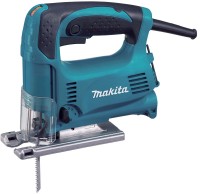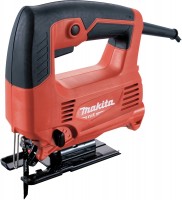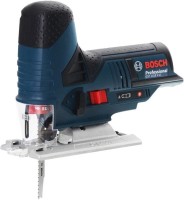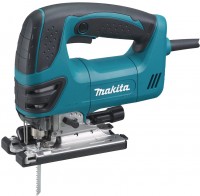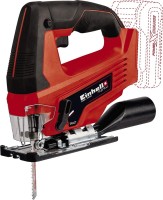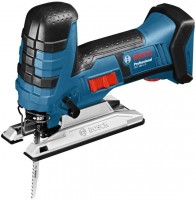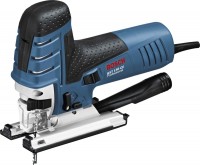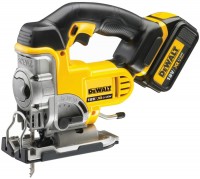Electric Jigsaws Bosch
All Electric Jigsaws Advanced filters → |
You might be interested in
Articles, reviews, useful tips
All materials
What is the best screwdriver?
Among thousands of screwdrivers, you can find one that surpasses the rest in all respects. Or is it impossible?

Which is better: drill, screwdriver or drill-driver?
We study the design features and specifics of the use of such similar, but still different types of power tools

How to choose an electric jigsaw?
Basics of choosing a jigsaw and selecting a saw blade for effective processing of wood, metal and drywall

Proper storage methods for power tool batteries
Conditions under which batteries will not lose capacity during extended storage

Five great cordless jigsaws for the home workshop
Cordless tools for sawing boards, cutting sheet lumber and cutting thin metal workpieces

One battery for the whole tool: multi-platform battery series
The concept of using a universal battery for cordless tools is gaining momentum
Electric Jigsaws: specifications, types
Show all
Type
— Portable. Relatively compact tool; during cutting, such a jigsaw is held in the hands and must be moved relative to a stationary workpiece. The main advantage of such models is obvious from their name — it is easy to carry: the jigsaw can be easily moved not only between work sites, but also between different jobs within the same site. On the other hand, portable models are less suitable for long-term work than stationary models — although their weight is relatively small, it is still quite significant, and holding on weight for a long time can be very tiring.
— Stationary. Jigsaws of this type resemble miniature sawmills: they have a base on which a frame with a saw blade is fixed, and the frame does not move during operation — instead, the operator must feed the workpiece in the right direction. Such tools are not as mobile as portable ones, they are noticeably heavier and more expensive, but they are much better at handling large volumes of work.
— Stationary. Jigsaws of this type resemble miniature sawmills: they have a base on which a frame with a saw blade is fixed, and the frame does not move during operation — instead, the operator must feed the workpiece in the right direction. Such tools are not as mobile as portable ones, they are noticeably heavier and more expensive, but they are much better at handling large volumes of work.
Real power
The power produced by the jigsaw “at the output”, in other words, supplied to the saw blade. It is always less than the power consumption (see above) due to energy losses in the tool mechanisms. It is the useful power that is the main parameter that determines the flow Rate and suitability of a jigsaw for heavy work: the higher the power, the thicker and/or harder the material the tool can “take” and the faster it can handle the job. On the other hand, tools with higher power consume more electricity (see “Power Consumption”), and are also noticeably heavier than less powerful counterparts. Therefore, it is worth choosing a jigsaw based on power, taking into account the expected volume of work and the characteristics of the materials used.
Power consumption
The maximum electrical power consumed by the jigsaw during operation. It is worth noting that this parameter uniquely determines only the amount of electricity spent on the operation of the tool; its practical characteristics, for example, the thickness of the material and the speed of operation, depend primarily on the output power (see below). On the other hand, the output power is not always indicated by the manufacturer, and therefore a comparison by power consumption is quite acceptable — to a certain extent, it allows you to evaluate the characteristics of the tool. So, it is believed that electric jigsaws up to 600 W are enough for domestic use, and more powerful models belong to the professional segment. For more information on selecting a jigsaw for power, see "Output Power".
Minimum frequency
The minimum stroke frequency of the jigsaw blade during operation. In some cases (for example, when working on metal), a low stroke rate is preferable to a high one; accordingly, the lower the minimum frequency, the more opportunities you will have to set up the instrument for working on a particular material.
Max. frequency
The maximum stroke frequency of the jigsaw blade during operation. The higher the stroke rate, the higher the performance of the tool and the cleaner and more accurate the cut, usually. On the other hand, high speed is not optimal for all materials; picking up a "high-speed" jigsaw is worth it if it is planned to be used mainly for woodworking.
Also note that the characteristics of the tool usually indicate the maximum frequency at idle; at work, it is usually less. However, this parameter quite allows you to compare different tools with each other.
Also note that the characteristics of the tool usually indicate the maximum frequency at idle; at work, it is usually less. However, this parameter quite allows you to compare different tools with each other.
Pendulum action
Possibility of work of a fret saw in the mode of the pendular course. In this mode, the working blade moves not only up and down, but also back and forth in such a way that contact with the material and sawing are carried out only when moving up. It is believed that the pendulum mode can increase the speed of work (especially when working with thick materials) and increase the life of the file. On the other hand, the quality of the cut using the pendulum stroke is worse than in the normal mode, and therefore it is not recommended to use it for precise work.
Stroke
The length of the stroke of the working blade of the jigsaw during operation. The longer the stroke, the more of the file will be in contact with the material in one movement; accordingly, at the same frequency of movement of the blade, a jigsaw with a longer stroke length will be more performant.
Blade length
The length of the cutting body of a stationary jigsaw, expressed in millimeters.
Max. cutting height
The highest workpiece height in millimeters that a jigsaw can overcome. Simply put, this is the maximum thickness of the workpiece to ensure a quality cut.
Max. cutting width
The maximum workpiece width in millimeters that a jigsaw can handle. The parameter is indicated mainly for desktop models of power tools. It determines the clearance from the cutting tool to the frame.
Shoe sizes
The size of the sole of the jigsaw is a plane that, during operation, is closely pressed against the workpiece and ensures its correct position relative to the saw blade. This parameter is important primarily for stationary models (see "Type"). On the one hand, a large sole makes it easier to work with large sheets of sawn material (especially if the thickness of such a sheet is small and it tends to bend); on the other hand, this indicator significantly affects the weight and dimensions of the unit. However, some manufacturers indicate the size of the sole for a portable tool.
Angled shoe
The maximum angle by which the sole of the jigsaw can deviate from the horizontal to the right or left (usually, the possibility of deviation in both directions is provided). The slope of the sole allows for bevel cuts. Most often, its angle does not exceed 45 °.
Handle
The shape of the jigsaw handle determines the way it is held during operation, as well as some application features. Today the following types of handles are used:
— D-shaped. Sometimes also called “staple-shaped”. True to its name, it is shaped like the letter “D” rotated 90°. The advantage of such jigsaws is the ability to work with one hand; on the other hand, they are poorly suitable for figured sawing, especially with complex shapes of cuts.
— Mushroom-shaped(rounded holder). In our catalog, this category includes all jigsaws equipped with an additional protrusion holder in the front part. This protrusion makes it easier to hold the tool with both hands, which is especially important when making cuts of complex shapes. Accordingly, such tools are considered more suitable for figure sawing. Among the disadvantages, visibility during operation is somewhat worse than in the case of a D-shaped handle.
— D-shaped. Sometimes also called “staple-shaped”. True to its name, it is shaped like the letter “D” rotated 90°. The advantage of such jigsaws is the ability to work with one hand; on the other hand, they are poorly suitable for figured sawing, especially with complex shapes of cuts.
— Mushroom-shaped(rounded holder). In our catalog, this category includes all jigsaws equipped with an additional protrusion holder in the front part. This protrusion makes it easier to hold the tool with both hands, which is especially important when making cuts of complex shapes. Accordingly, such tools are considered more suitable for figure sawing. Among the disadvantages, visibility during operation is somewhat worse than in the case of a D-shaped handle.
Wood
Maximum cutting depth in wood, in other words — the maximum thickness of a wooden workpiece that a jigsaw can handle. This parameter characterizes not only directly the maximum thickness of the material, but also the performance of the tool as a whole: the greater the depth of cut, the higher the performance. In the case of wood for domestic use, a depth of about 70 mm is considered sufficient, deeper models are usually professional.
It is worth noting that the depth of cut is usually indicated for certain files recommended by the manufacturer for a particular material. The use of other canvases does not guarantee compliance with the claimed parameters, and in some cases it is even fraught with breakdowns and injuries.
It is worth noting that the depth of cut is usually indicated for certain files recommended by the manufacturer for a particular material. The use of other canvases does not guarantee compliance with the claimed parameters, and in some cases it is even fraught with breakdowns and injuries.
Aluminium
The maximum cutting depth when working on aluminum and its alloys, in other words, the maximum thickness of a workpiece made of these materials that a jigsaw can cut through. In general, aluminum and its alloys are softer than steel, and therefore the depth of cut through them is greater - in professional models it can reach 30 mm.
Steel
The maximum depth of cut in steel, in fact, is the maximum thickness of a workpiece made of steel or other metal of similar characteristics that a jigsaw can handle. For more information about the depth of cut, see "Wood", here we note that due to the hardness of the material, even in professional models, this parameter rarely exceeds 10 mm.
Functions
— Soft start. With a normal start, the jigsaw motor reaches operating speed very quickly. A sharp jerk of the tool at the same time can ruin the work and increases the risk of letting the jigsaw out of your hands, which is fraught with various unpleasant consequences. In addition, high starting currents, characteristic of modern electric motors, increase their wear and tear, and are undesirable for the power grid. The soft start system avoids the troubles described above: the speed increases smoothly, the jerk of the tool is minimal, and the starting currents are low. This feature is especially important for high power jigsaws (from 600 W).
— Adjustment of turns. This function allows you to select the optimal stroke rate for different types of materials: for example, soft materials such as wood can be worked at high speeds, while hard materials (metal, ceramics, etc.) are recommended to be worked at low speed. See "Min. frequency" and "Maximum frequency".
— Presetting the number of revolutions. The function provides the fastest speed presetting. The stroke rate of the cutting tool is selected for optimal work with workpieces made of certain materials.
— Maintaining momentum. An electronic system that regulates the power supplied to the working tool so that the speed of its work is constant regardless of the load. This improves the quality and pro...ductivity of work, as well as the service life of the tool and the jigsaw itself.
— Brushless motor. The presence of a brushless electric motor in the jigsaw. The carbon brushes used in traditional electric motors run with a lot of friction, get very hot, tend to spark, and wear out relatively quickly. Accordingly, brushless motors are safer, more economical and more durable. Their main disadvantage is their high cost.
— Keyless file replacement. The ability to replace the jigsaw blade without the use of special tools (wrenches, screwdrivers, etc.) — thanks to a special mount that can be opened and closed by hand. This feature greatly simplifies and facilitates the process of changing the blade.
— Anti-vibration system. A mechanism or system of mechanisms designed to reduce the vibration of a tool during operation. Strong vibrations not only worsen the quality and accuracy of cuts, but also increase tool wear, lead to rapid fatigue of the operator, and during prolonged work, they also adversely affect health. To prevent all this, various designs are used in the form of shock absorbers, counterweights, etc.
— Sawdust blowing system. The possibility of blowing sawdust from the place of cutting directly during the operation of the jigsaw. It is usually implemented by a fan that provides cooling for the electric motor: the air flow is directed to the web, and the resulting waste is immediately blown away. Thus, the sawdust does not cover the marking line, which greatly facilitates the work, especially with complex figured cuts.
— Connecting a vacuum cleaner. Possibility of connecting an external vacuum cleaner to the jigsaw; for this, the tool is equipped with a special nozzle. The role of such a vacuum cleaner is similar to the blowing system (see above): it is primarily designed to clean the cutting line from sawdust and other debris. However, at the same time, the vacuum cleaner also additionally ensures cleanliness: sawdust does not scatter around the room, but is collected in a dust collector. At the same time, there is a drawback: the tool becomes more cumbersome and less suitable for complex jobs.
— Built-in lighting. The jigsaw has its own lighting system in the form of a flashlight aimed at the work area. Such a tool allows you to work in low light conditions without any additional light sources.
— Laser marker. The presence of a laser marker-target designator in an electric jigsaw: such a marker projects a light mark onto the workpiece during operation, which indicates where the cut will go. This greatly improves the accuracy of the work.
— Adjustment of turns. This function allows you to select the optimal stroke rate for different types of materials: for example, soft materials such as wood can be worked at high speeds, while hard materials (metal, ceramics, etc.) are recommended to be worked at low speed. See "Min. frequency" and "Maximum frequency".
— Presetting the number of revolutions. The function provides the fastest speed presetting. The stroke rate of the cutting tool is selected for optimal work with workpieces made of certain materials.
— Maintaining momentum. An electronic system that regulates the power supplied to the working tool so that the speed of its work is constant regardless of the load. This improves the quality and pro...ductivity of work, as well as the service life of the tool and the jigsaw itself.
— Brushless motor. The presence of a brushless electric motor in the jigsaw. The carbon brushes used in traditional electric motors run with a lot of friction, get very hot, tend to spark, and wear out relatively quickly. Accordingly, brushless motors are safer, more economical and more durable. Their main disadvantage is their high cost.
— Keyless file replacement. The ability to replace the jigsaw blade without the use of special tools (wrenches, screwdrivers, etc.) — thanks to a special mount that can be opened and closed by hand. This feature greatly simplifies and facilitates the process of changing the blade.
— Anti-vibration system. A mechanism or system of mechanisms designed to reduce the vibration of a tool during operation. Strong vibrations not only worsen the quality and accuracy of cuts, but also increase tool wear, lead to rapid fatigue of the operator, and during prolonged work, they also adversely affect health. To prevent all this, various designs are used in the form of shock absorbers, counterweights, etc.
— Sawdust blowing system. The possibility of blowing sawdust from the place of cutting directly during the operation of the jigsaw. It is usually implemented by a fan that provides cooling for the electric motor: the air flow is directed to the web, and the resulting waste is immediately blown away. Thus, the sawdust does not cover the marking line, which greatly facilitates the work, especially with complex figured cuts.
— Connecting a vacuum cleaner. Possibility of connecting an external vacuum cleaner to the jigsaw; for this, the tool is equipped with a special nozzle. The role of such a vacuum cleaner is similar to the blowing system (see above): it is primarily designed to clean the cutting line from sawdust and other debris. However, at the same time, the vacuum cleaner also additionally ensures cleanliness: sawdust does not scatter around the room, but is collected in a dust collector. At the same time, there is a drawback: the tool becomes more cumbersome and less suitable for complex jobs.
— Built-in lighting. The jigsaw has its own lighting system in the form of a flashlight aimed at the work area. Such a tool allows you to work in low light conditions without any additional light sources.
— Laser marker. The presence of a laser marker-target designator in an electric jigsaw: such a marker projects a light mark onto the workpiece during operation, which indicates where the cut will go. This greatly improves the accuracy of the work.
Power source
— Network. Power jigsaw from a conventional household network 220 watts. The advantages of such a power supply are reliability combined with high power. So, the tool will work as long as there is voltage in the network, and you do not have to worry about whether the battery is enough. And the characteristics of this network usually allow you to power jigsaws of any power, including professional models. On the other hand, the ability to move such a tool is limited by the length of the power cord, the location of the nearest outlet and the availability of extension cords.
— Battery. The electric jigsaw is powered by its own built-in battery. The main advantage of this type of power supply is maximum battery life: the tool can be used anywhere, regardless of whether there is an electrical network nearby, and there is no power cord in the design that tends to interfere and get tangled. At the same time, the battery life is limited, charging it can take quite a long time and still require the presence of the mains. In addition, batteries significantly increase the weight of the tool, and it is rather problematic to provide high power to the tool with such power supply.
— Battery. The electric jigsaw is powered by its own built-in battery. The main advantage of this type of power supply is maximum battery life: the tool can be used anywhere, regardless of whether there is an electrical network nearby, and there is no power cord in the design that tends to interfere and get tangled. At the same time, the battery life is limited, charging it can take quite a long time and still require the presence of the mains. In addition, batteries significantly increase the weight of the tool, and it is rather problematic to provide high power to the tool with such power supply.
Battery in set
Number of batteries supplied with the corresponding tool (see “Power source”). This item may also indicate the presence of a built-in battery.
The included battery allows you to use the device right out of the box. To expand the capabilities, manufacturers can equip the electric lobster with two or more batteries. This provides additional benefits that are especially convenient when using the tool for long periods of time. So, when the charge of one battery is exhausted, you can quickly exchange it for another; while one battery is in use, the second one can be charged. This allows charging interruptions to be minimized or eliminated altogether.
In addition, many modern cordless tools are supplied without batteries. This configuration assumes that the user will purchase additional batteries at his own discretion (many models are compatible with several brands of batteries at once). In addition, this option can be useful if the battery is already on the household. This happens quite often, since many well-known manufacturers use universal batteries suitable for different types of branded power tools. So a battery, for example, from a previously purchased screwdriver or sander may well be compatible with a jigsaw from the same company.
As for non-removable batteries, this is a rather rare and specific option. Such tools turn out to be as compact as possible, but the batteries themselves cannot be quickly changed - so during work you will inevitably...have to take breaks to charge. Therefore, this power supply method is typical for low-power instruments. In them, small size is more important than a long period of continuous operation; moreover, the low capacity allows you to achieve good autonomy even with small sizes (and, accordingly, capacity) of batteries.
The included battery allows you to use the device right out of the box. To expand the capabilities, manufacturers can equip the electric lobster with two or more batteries. This provides additional benefits that are especially convenient when using the tool for long periods of time. So, when the charge of one battery is exhausted, you can quickly exchange it for another; while one battery is in use, the second one can be charged. This allows charging interruptions to be minimized or eliminated altogether.
In addition, many modern cordless tools are supplied without batteries. This configuration assumes that the user will purchase additional batteries at his own discretion (many models are compatible with several brands of batteries at once). In addition, this option can be useful if the battery is already on the household. This happens quite often, since many well-known manufacturers use universal batteries suitable for different types of branded power tools. So a battery, for example, from a previously purchased screwdriver or sander may well be compatible with a jigsaw from the same company.
As for non-removable batteries, this is a rather rare and specific option. Such tools turn out to be as compact as possible, but the batteries themselves cannot be quickly changed - so during work you will inevitably...have to take breaks to charge. Therefore, this power supply method is typical for low-power instruments. In them, small size is more important than a long period of continuous operation; moreover, the low capacity allows you to achieve good autonomy even with small sizes (and, accordingly, capacity) of batteries.
Battery platform
The name of the battery platform supported by the device. A single battery platform is used to combine various power tools of the same brand (screwdriver, grinder, circular saw, etc.) into one line. Devices on the same platform use interchangeable batteries and chargers. Thanks to this, for example, there is no need to select a battery for each individual power tool model, because one purchased as a spare battery can be used in various power tools, depending on the situation or as needed. Batteries of the same platform basically differ from each other except perhaps in capacity.
Battery voltage
The voltage of the standard jigsaw battery. In modern models, it can range from 12 V to 36 V. In fact, the power of the tool is primarily related to the battery voltage: more powerful jigsaws require, respectively, batteries with a higher voltage.
Battery type
The type of battery used in the jigsaw. In modern models, the following types of batteries can be used:
— Ni-Cd. Nickel-cadmium batteries are the most "old" type of battery used today. Such batteries are reliable, sufficiently capacious, resistant to temperature extremes, and also withstand high charging currents, which reduces the charge time. At the same time, Ni-Cd batteries have the so-called “memory effect”: if such a battery is charged without being completely discharged before, its capacity decreases (although this process is not irreversible). In addition, cadmium contained in batteries is considered environmentally hazardous.
— Ni-Mh. Nickel-metal hydride batteries. Developed as a more advanced alternative to nickel-cadmium cells (see above), devoid of their main disadvantages. Indeed, Ni-Mh batteries are almost not subject to the “memory effect” and are much more environmentally friendly, at the same time they tolerate temperature changes without problems and hold voltage well. The disadvantages of Ni-Mh are a somewhat shorter service life and the need to store it in a charged state.
— Li-Ion. Lithium-ion batteries were originally used primarily in portable electronics, but relatively recently they have been installed in power tools. Such batteries have a good energy density, in other words, they have a high capacity at a small size and weight. In addition, they are not subject to the “memory effect” and charge fairly quickly. Among the...shortcomings can be noted the high cost, as well as increased sensitivity to low temperatures.
— Ni-Cd. Nickel-cadmium batteries are the most "old" type of battery used today. Such batteries are reliable, sufficiently capacious, resistant to temperature extremes, and also withstand high charging currents, which reduces the charge time. At the same time, Ni-Cd batteries have the so-called “memory effect”: if such a battery is charged without being completely discharged before, its capacity decreases (although this process is not irreversible). In addition, cadmium contained in batteries is considered environmentally hazardous.
— Ni-Mh. Nickel-metal hydride batteries. Developed as a more advanced alternative to nickel-cadmium cells (see above), devoid of their main disadvantages. Indeed, Ni-Mh batteries are almost not subject to the “memory effect” and are much more environmentally friendly, at the same time they tolerate temperature changes without problems and hold voltage well. The disadvantages of Ni-Mh are a somewhat shorter service life and the need to store it in a charged state.
— Li-Ion. Lithium-ion batteries were originally used primarily in portable electronics, but relatively recently they have been installed in power tools. Such batteries have a good energy density, in other words, they have a high capacity at a small size and weight. In addition, they are not subject to the “memory effect” and charge fairly quickly. Among the...shortcomings can be noted the high cost, as well as increased sensitivity to low temperatures.
Battery capacity
Battery capacity refers to the amount of energy it can store when fully charged. Measured in ampere-hours (Ah): 1 Ah means the amount of energy sufficient to provide a current of 1 A for 1 hour. The higher the battery capacity, the longer the jigsaw can work on a single charge.
Note that in fact, the operating time of battery models depends not only on the battery capacity, but also on the specifics of the work. For example, cutting harder and/or thick material and energy will be spent more than soft and thin; accordingly, the operating time in the first case will be less than in the second.
Note that in fact, the operating time of battery models depends not only on the battery capacity, but also on the specifics of the work. For example, cutting harder and/or thick material and energy will be spent more than soft and thin; accordingly, the operating time in the first case will be less than in the second.
Battery type
The model of a standard battery allows you to find out its characteristics in more detail, and also helps you understand what devices it is like and which one should be purchased in case of a replacement due to a malfunction or, if necessary, buy another similar one.
Compatible batteries
Battery models compatible with the tool.
When choosing a tool, this information is relevant mainly for models without a battery in the kit (see "Complete battery"). For tools shipped with batteries, the battery model is more of a guideline - it's mostly "for the future" if a spare or replacement battery is needed. However, this data can also be useful during the selection process - for example, to assess compatibility with an existing battery in the household, or to find detailed data on compatible batteries and determine how they meet your requirements (in particular, there are formulas that allow you to determine the time of continuous operation from a specific battery; these formulas can be found in special sources).
When choosing a tool, this information is relevant mainly for models without a battery in the kit (see "Complete battery"). For tools shipped with batteries, the battery model is more of a guideline - it's mostly "for the future" if a spare or replacement battery is needed. However, this data can also be useful during the selection process - for example, to assess compatibility with an existing battery in the household, or to find detailed data on compatible batteries and determine how they meet your requirements (in particular, there are formulas that allow you to determine the time of continuous operation from a specific battery; these formulas can be found in special sources).
Charging time
The time to fully charge the battery that the tool is equipped with from a standard charger (when using other batteries or a “non-native” charger, this time may vary both in one direction and in the other).
For cordless tools in general, see "Power Source". And charging time data gives you an idea of how you'll need to organize your workflow and how long breaks you'll need to charge your batteries. The specific duration of the process will depend both on the capacity of the battery (ceteris paribus, a more capacious model takes longer to charge), and on the technologies used by the manufacturer to increase charging efficiency.
We also note that the specific meaning of this parameter also depends on the number of batteries in the kit. Recall that there are often several of them at once (see "Complete battery"), and while one battery is working, the rest can be charged. This allows you to reduce interruptions to a minimum, and even completely do without them. But if there is only one battery, charging breaks will inevitably be required in full. This is especially true for tools with a built-in power source (in models with replaceable batteries, the situation can be corrected by purchasing additional batteries).
For cordless tools in general, see "Power Source". And charging time data gives you an idea of how you'll need to organize your workflow and how long breaks you'll need to charge your batteries. The specific duration of the process will depend both on the capacity of the battery (ceteris paribus, a more capacious model takes longer to charge), and on the technologies used by the manufacturer to increase charging efficiency.
We also note that the specific meaning of this parameter also depends on the number of batteries in the kit. Recall that there are often several of them at once (see "Complete battery"), and while one battery is working, the rest can be charged. This allows you to reduce interruptions to a minimum, and even completely do without them. But if there is only one battery, charging breaks will inevitably be required in full. This is especially true for tools with a built-in power source (in models with replaceable batteries, the situation can be corrected by purchasing additional batteries).
Charge level indicator
An indicator that signals the battery level in the corresponding tool (see "Power supply").
The device and capabilities of such a pointer can vary from an LED “light” that gives the simplest signals by changing color and / or blinking frequency, to detailed data on the instrument’s own display (see “Functions”). However, in any case, the charge level indicator makes it easier to monitor the state of the battery and reduces the likelihood of being with an “empty” battery at the wrong time.
The device and capabilities of such a pointer can vary from an LED “light” that gives the simplest signals by changing color and / or blinking frequency, to detailed data on the instrument’s own display (see “Functions”). However, in any case, the charge level indicator makes it easier to monitor the state of the battery and reduces the likelihood of being with an “empty” battery at the wrong time.
Battery mount
Method of attaching the battery to the tool.
- Clip. With this fixation, the battery is fully or partially inserted into the handle of the tool - like a clip (magazine) of a pistol, hence the name. This method is convenient in that when installing the battery, there is a minimum of unnecessary parts outside; and small low-power batteries can completely hide inside the case without affecting the dimensions of the tool. On the other hand, for powerful and capacious power supplies that are of considerable size and weight, the clip-on mounting method is poorly suited for a number of reasons. Therefore, this option is much less common than sliders, and mainly among low-power instruments.
— Slider. This method involves the use of special guides - a kind of "sled" along which the battery moves during installation and removal; such "sledges" are usually placed at the bottom, at the end of the handle. The slider is suitable for batteries of almost any size and weight, including the most powerful and heavy batteries used in power tools. In addition, it does not have such severe restrictions on the shape of the battery as a clip-type mount. So most modern cordless tools use sliders, and for medium and high power units, this option is almost standard. Its disadvantages include perhaps the moment that the installed battery is located outside the tool and somewhat increases its dimensions. However, this point most often turns out to be unprincipled - especially for powe...rful and heavy devices that are initially quite large.
- Clip. With this fixation, the battery is fully or partially inserted into the handle of the tool - like a clip (magazine) of a pistol, hence the name. This method is convenient in that when installing the battery, there is a minimum of unnecessary parts outside; and small low-power batteries can completely hide inside the case without affecting the dimensions of the tool. On the other hand, for powerful and capacious power supplies that are of considerable size and weight, the clip-on mounting method is poorly suited for a number of reasons. Therefore, this option is much less common than sliders, and mainly among low-power instruments.
— Slider. This method involves the use of special guides - a kind of "sled" along which the battery moves during installation and removal; such "sledges" are usually placed at the bottom, at the end of the handle. The slider is suitable for batteries of almost any size and weight, including the most powerful and heavy batteries used in power tools. In addition, it does not have such severe restrictions on the shape of the battery as a clip-type mount. So most modern cordless tools use sliders, and for medium and high power units, this option is almost standard. Its disadvantages include perhaps the moment that the installed battery is located outside the tool and somewhat increases its dimensions. However, this point most often turns out to be unprincipled - especially for powe...rful and heavy devices that are initially quite large.
Replaceable battery
Replaceable battery. The ability to quickly remove and replace the battery in battery-powered jigsaws (see "Power source"). This feature allows you to significantly extend the battery life of the tool without the need for a long charge: with a "fresh" battery ready, when the charge is exhausted, you just need to replace the battery - and you can continue to work. Most jigsaws with this feature come with an extra battery included, and if necessary, batteries can be purchased separately.
Cable length
The length of the network cable can tell you how far from the outlet you can operate the device. Therefore, for domestic use, it is more relevant to choose models with a short cord, for construction work or use in production, in the garage a longer cable is better.
In box
- Charger. A device for charging the batteries used in the tool with the appropriate power supply. For models supplied with such a device, the charger model may be additionally specified in the characteristics. This information can be useful not only for finding a spare or replacement charger, but also in case the household has other cordless tools and / or batteries for them. On the other hand, a lot of modern cordless tools come without a charger at all. This option will be optimal, first of all, if a compatible memory is already available, and there is simply no need to overpay for a second device. In addition, the lack of a charger will be appreciated by those who want to choose this accessory separately, without relying on the manufacturer's decision.
- Rubberized handle. The presence of a rubber pad on the handle of the jigsaw. Rubber provides a more secure hold on the tool than plastic, and also helps reduce vibration transmitted to the operator's hands. In some models, rubber pads are made corrugated - for additional reliability.
- Protective shield. The presence in the design of the jigsaw of a transparent (usually plexiglass) protective shield in the front, near the file. It prevents fine sawdust from being scattered during operation, and also improves blowing or suction efficiency (if these functions are present, see "Functions/Features" for more details). In most cases, the p...rotective shield is made removable.
- Case included. The presence of a special suitcase-case in the delivery set of the jigsaw. Such a case greatly facilitates storage and transportation, because. initially “sharpened” for a specific jigsaw model. In addition, additional accessories can usually be stored in it: replacement files, a tool for changing them (if required), a spare battery, etc.
- Flexible shaft. The flexible shaft is a special kind of auxiliary nozzle. Outwardly, this device looks like a hose, sometimes quite long. One end of such a "hose" is attached to the cartridge, and the other has its own cartridge, where the working nozzle is attached - rotation is transmitted to it due to the shaft located inside the "hose". The part of the flexible shaft held in the hands during operation is more compact and lighter than the jigsaw itself, so the most popular ways to use such equipment are the processing of hard-to-reach places (where the tool simply cannot crawl through) and fine work (which is difficult to do with a massive machine).
- Pedal. The presence of the pedal frees the hands of the master and allows you to adjust the speed of rotation of the nozzle by changing the pressure on the pedal. The dependence here is directly proportional - the stronger the pressure, the higher the speed.
- Rubberized handle. The presence of a rubber pad on the handle of the jigsaw. Rubber provides a more secure hold on the tool than plastic, and also helps reduce vibration transmitted to the operator's hands. In some models, rubber pads are made corrugated - for additional reliability.
- Protective shield. The presence in the design of the jigsaw of a transparent (usually plexiglass) protective shield in the front, near the file. It prevents fine sawdust from being scattered during operation, and also improves blowing or suction efficiency (if these functions are present, see "Functions/Features" for more details). In most cases, the p...rotective shield is made removable.
- Case included. The presence of a special suitcase-case in the delivery set of the jigsaw. Such a case greatly facilitates storage and transportation, because. initially “sharpened” for a specific jigsaw model. In addition, additional accessories can usually be stored in it: replacement files, a tool for changing them (if required), a spare battery, etc.
- Flexible shaft. The flexible shaft is a special kind of auxiliary nozzle. Outwardly, this device looks like a hose, sometimes quite long. One end of such a "hose" is attached to the cartridge, and the other has its own cartridge, where the working nozzle is attached - rotation is transmitted to it due to the shaft located inside the "hose". The part of the flexible shaft held in the hands during operation is more compact and lighter than the jigsaw itself, so the most popular ways to use such equipment are the processing of hard-to-reach places (where the tool simply cannot crawl through) and fine work (which is difficult to do with a massive machine).
- Pedal. The presence of the pedal frees the hands of the master and allows you to adjust the speed of rotation of the nozzle by changing the pressure on the pedal. The dependence here is directly proportional - the stronger the pressure, the higher the speed.


